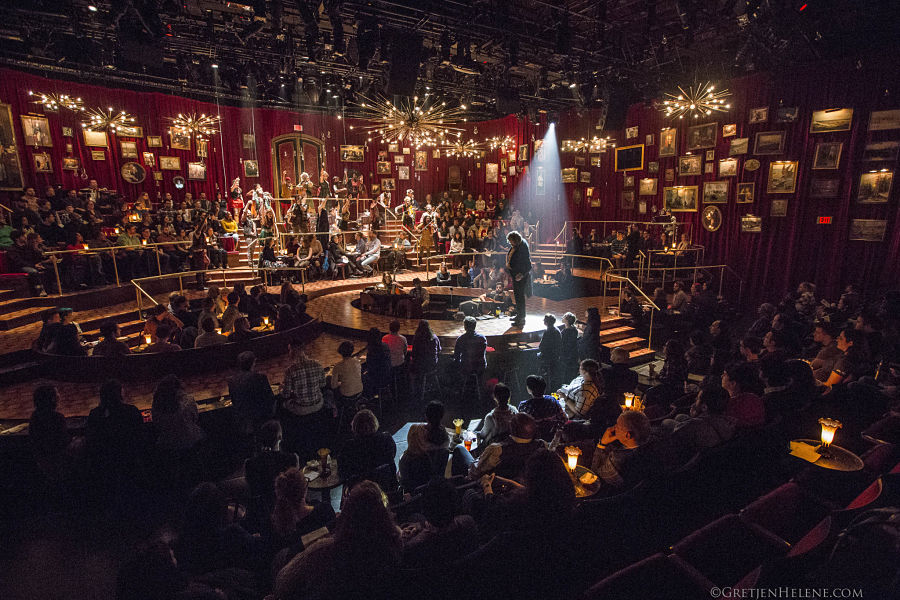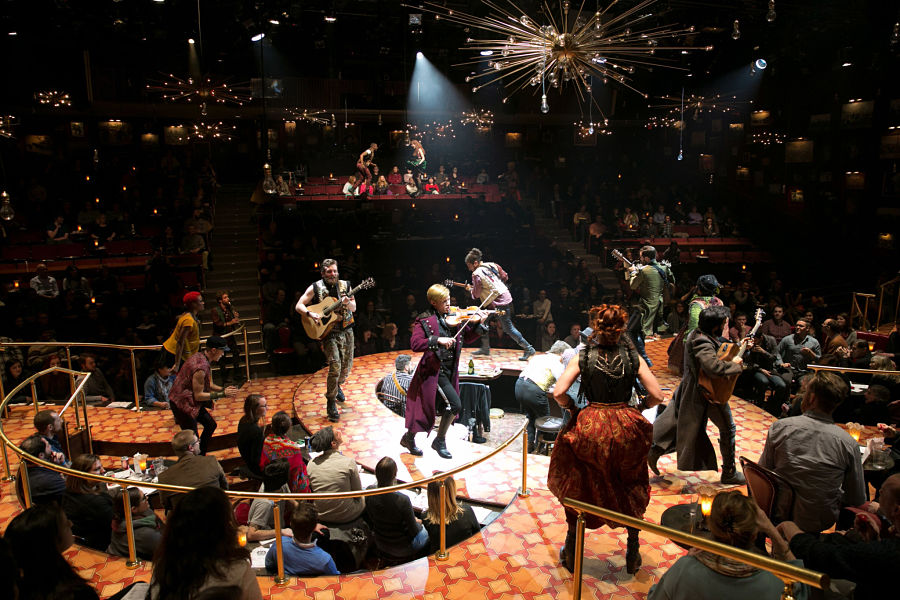Broadway and immersive theatre seem diametrically opposed, as the Main Stem is synonymous with huge houses, high ticket prices, and a pretty firm fourth wall, while immersive theatre demands an intimate space, actors swirling through the audience, and a sort of voyeuristic proximity to the action. Immersive theatre usually pops up around the audience, while Broadway shows generally adhere to the traditional architecture of a theatre space.
But come September 2016, we’ll see these genres come together. Currently running at American Repertory Theater in Cambridge, Mass., is Dave Malloy’s Natasha, Pierre and the Great Comet of 1812, a musical staged immersively in a traditional space, which will make a long-anticipated move to Broadway next fall with singer Josh Groban in the lead (Groban is not in the current ART production).
Whispers of a Broadway transfer have been following Great Comet since it was first produced in 2012 at Ars Nova in New York City. But instead of moving the show then, the producers built Kazino, a 199-seat tent-cum-supper club in Manhattan’s Meatpacking District, where the show played in 2013. The apparatus then moved to Times Square, and the show concluded its run in 2014. A Broadway transfer never materialized, and the show remained unproduced for a year and a half. But with the announcement of the ART production, many assumed that the restaging of the popular show in the theatre’s proscenium space was an effort to adapt the show to a more Broadway-friendly mold. The assumptions, as today’s announcement in the New York Times makes clear, were correct.
In order to bring a new audience experience to a large, traditional house, set designer Mimi Lien had to remove, reimagine, and reinvent traditional barriers between the audience and the actors. Thanks to Lien, ART’s 540-seat Loeb Drama Center feels more intimate and inclusive than ever. The stage has been transformed into an opulent, velvet-laden Russian supper club with additional seating sections constructed around and sunken into the stage.
“I felt the musicality of the piece, and the way it wanted to move was in this sweeping promenade rhythm,” Lien explains of her design. “So I kept drawing these curving platforms without really knowing why. It felt really right.” Her inclination toward curvature also made her design concept expandable. “In a way, the ground plan is ornament,” she continues. “I found I could very easily add a little loop here or a little flourish there. It is an idea able to be expanded in a way that grows very naturally, keeping the concept intact.”
Initially, this architectural reimagining weighed heavily on Lien. “I was very worried about the seats in the house because I felt the experience of proximity was very important,” she confesses. “The first thing we asked was: ‘Can we take the seats out?’ But they’re lag-bolted into concrete, so that was not a possibility. The next option was building on top of the seats.”
So that’s what she did. Platforms built atop fixed seats in the middle of the house allow scenes to be staged in the heart of the audience. “You get a different experience [in the orchestra section],” Lien says. “You don’t have quite the same proximity [as the onstage seats], but I think we’ve succeeded in creating an entire room where you feel the same energy.”

Both Malloy and director Rachel Chavkin reiterate Lien’s confidence in the new design. “No matter where you are in the audience, there’s always someone running right past you, and you get those private moments with Natasha or with Pierre,” Malloy says. And Chavkin thinks the additional space has been a blessing to the show. “Being in a larger space has meant a scene can really translate on a visual level across space, as well as on the visceral level of proximity to the audience,” she says. “And at the heart of it are these extraordinary performances by actors working simultaneously on cinematic and operatic scales, because some audience members are 200 feet away and some are 2 feet away.”
Still, an individual’s experience of the show is contingent on where they sit. This is where the architecture of the theatre can get in the way . The action is skewed toward the onstage sections simply because it must be. When I saw the production, I didn’t sit onstage, and while I definitely felt the energy of the show, I longed to be onstage in the thick of the action. Although the creative team are doing the best they can to reach all corners of the audience—my favorite moment was when everyone in the audience received an egg shaker to play along to the music—I couldn’t help but feel as though I was still missing out on something that was better experienced from those sunken lounge seats on the stage. While I still loved the show from my bird’s-eye view, it did not fully satisfy my desire for immersive theatre.
And the question remains: Will it work on Broadway in the same way it works in this fairly flexible resident theatre? Nearly every Broadway theatre has a proscenium , except for Circle in the Square, where Fun Home is currently playing in the round. Lien and Chavkin have proven that architecture can be overcome to a certain degree, but the size of some Broadway houses is nearly double or even triple that of the Loeb. Malloy seconds these concerns. “I think there still are Broadway houses where this show probably wouldn’t work—some of the gigantic behemoth ones,” he says. “I think you’d lose too much. But we wanted to see what it felt like in a 600-seat house, and there are Broadway theatres that size.”
Mezzanine and balcony sections will add to the space that the set and the cast must cover. A seating hierarchy also leads to a pricing hierarchy. Center orchestra seats can run up to $500 a pop for popular shows on Broadway, and the even more limited nature of those onstage seats could come with either an unheard of price tag or sell out within seconds. The immersive experience would no longer be egalitarian or accessible for a large portion of the audience.
So a Broadway production of Great Comet have its pitfalls and shortcomings, of course. What piece of theatre doesn’t, especially one with so many structural challenges? Maybe the ideal solution would be to build a new Broadway theatre: a house without a proscenium stage, without fixed audience seating, and without the structure and the tradition of the old Broadway. This show has already proven it can break barriers. Why not break another?
Jen Gushue is a freelance writer and is currently the marketing associate at Miller Theatre.


